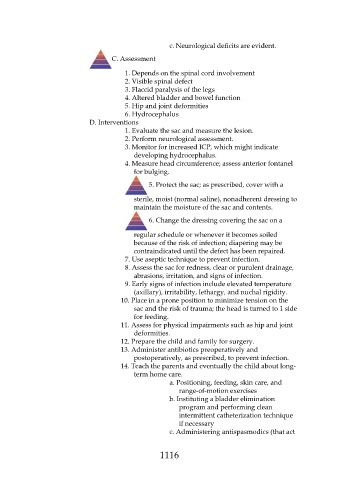Page 1116 - Saunders Comprehensive Review For NCLEX-RN
P. 1116
c. Neurological deficits are evident.
C. Assessment
1. Depends on the spinal cord involvement
2. Visible spinal defect
3. Flaccid paralysis of the legs
4. Altered bladder and bowel function
5. Hip and joint deformities
6. Hydrocephalus
D. Interventions
1. Evaluate the sac and measure the lesion.
2. Perform neurological assessment.
3. Monitor for increased ICP, which might indicate
developing hydrocephalus.
4. Measure head circumference; assess anterior fontanel
for bulging.
5. Protect the sac; as prescribed, cover with a
sterile, moist (normal saline), nonadherent dressing to
maintain the moisture of the sac and contents.
6. Change the dressing covering the sac on a
regular schedule or whenever it becomes soiled
because of the risk of infection; diapering may be
contraindicated until the defect has been repaired.
7. Use aseptic technique to prevent infection.
8. Assess the sac for redness, clear or purulent drainage,
abrasions, irritation, and signs of infection.
9. Early signs of infection include elevated temperature
(axillary), irritability, lethargy, and nuchal rigidity.
10. Place in a prone position to minimize tension on the
sac and the risk of trauma; the head is turned to 1 side
for feeding.
11. Assess for physical impairments such as hip and joint
deformities.
12. Prepare the child and family for surgery.
13. Administer antibiotics preoperatively and
postoperatively, as prescribed, to prevent infection.
14. Teach the parents and eventually the child about long-
term home care.
a. Positioning, feeding, skin care, and
range-of-motion exercises
b. Instituting a bladder elimination
program and performing clean
intermittent catheterization technique
if necessary
c. Administering antispasmodics (that act
1116

